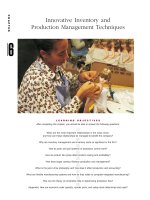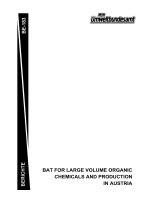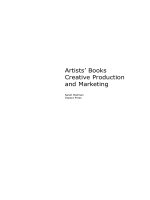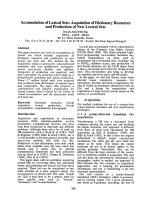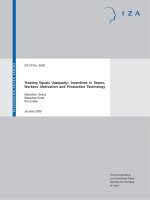Prices and production
Bạn đang xem bản rút gọn của tài liệu. Xem và tải ngay bản đầy đủ của tài liệu tại đây (9.54 MB, 174 trang )
First published September 1931
Reprinted January 1932
Second edition (revised and enlarged) 1935
Reprinted 1941, 1946, 1949, 1951, 1957, 1960 and 1967
Published in the U.S.A. by Augustus M. Kelly, Publishers
New York
Library of Congress Catalogue Number
67-19586
Printed in Great Britain
CONTENTS
PAGE
PREFACE TO THE SECOND EDITION
LECTURE I :
..
..
..
THE
CONSUMERS'
PRODUCTION
PRODUCTION
GOODS
OF
AND
OF
THE
PRODUCERS'
GOODS
III:
i
THE CONDITIONS OF EQUILIBRIUM
BETWEEN
„
vii
THEORIES OF THE INFLUENCE OF
MONEY ON PRICES
II:
..
THE
32
WORKING
OF
THE
PRICE
MECHANISM IN THE COURSE OF
THE CREDIT CYCLE
IV:
..
..
69
THE CASE FOR AND AGAINST AN
" ELASTIC " CURRENCY
..
105
APPENDIX : CAPITAL AND INDUSTRIAL FLUCTUATIONS.
A Reply to a Criticism
132
PREFACE TO THE SECOND EDITION
book owes its existence to an invitation by the
University of London to deliver during the session
I
93°-3 I four lectures to advanced students in economics,
and in the form in which it was first published it literally
reproduced these lectures. This invitation offered to
me what might easily have been a unique opportunity
to lay before an English audience what contribution I
thought I had then to make to current discussions of
theoretical economics ; and it came at a time when I
had arrived at a clear view of the outlines of a theory of
industrial fluctuations but before I had elaborated it in
full detail or even realised all the difficulties which such
an elaboration presented. The exposition, moreover,
was limited to what I could say in four lectures, which
inevitably led to even greater oversimplification than I
would probably have been guilty of in any other case.
But although I am now conscious of many more defects
of this exposition than I was even at the time of its
first publication, I can only feel profoundly grateful to
the circumstances which were such an irresistible temptation to publish these ideas at an earlier date than I
should otherwise have done. From the criticisms and
discussions that publication has caused I hope to have
profited more for a later more complete exposition than
I could possibly have done if I had simply continued to
THIS
vii
viii
PREFACE TO THE SECOND EDITION
work on these problems for myself. But the time
for that more exhaustive treatment of these problems
has not yet come. It is perhaps the main gain which
I derived from the early publication that it made it
clear to me that before I could hope to get much
further with the elucidation of the main problems
discussed in this book it would be necessary considerably
to elaborate the foundations on which I have tried to
build. Contact with scientific circles which were less
inclined than I was to take for granted the main propositions of the " Austrian " theory of capital on which
I have drawn so freely in this book has shown—not
that these propositions were wrong or that they were less
important than I had thought for the task for which I
had used them—but that they would have to be developed in far greater detail and have to be adapted much
more closely to the complicated conditions of real life
before they could provide a completely satisfactory
instrument for the explanation of the particularly complicated phenomena to which I have applied them.
This is a task which has to be undertaken before the
theses expounded in the present book can be developed
further with advantage.
Under these circumstances, when a new edition of
this book was called for, I felt neither prepared to rewrite
and enlarge it to the extent that a completely adequate
treatment of the problems taken up would make necessary, nor to see it reappear in an altogether unchanged
form. The compression of the original exposition has
given rise to so many unnecessary misunderstandings
PREFACE TO THE SECOND EDITION
ix
which a somewhat fuller treatment would have prevented that certain additions seemed urgently necessary. I have accordingly chosen the middle course of
inserting into the, on the whole unchanged, original
text further elucidations and elaborations where they
seemed most necessary. Many of these additions were
already included in the German edition which appeared
a few months after the first English edition.
Others
are taken over from a number of articles in which in the
course of the last three years I have tried to develop or
to defend the main thesis of this book. It has, however,
been by no means possible to incorporate all the further
elaborations attempted in these articles in the present
volume and the reader who may wish to refer to them
will find them listed in the footnote below.1
By these modifications I hope to have removed at
least some of the difficulties which the book seems to
have presented in its original form. Others were due
to the fact that the book was in some ways a continuation of an argument which I had begun in other publications that at the time of its first appearance were
available only in German. In the meantime English
1
" The Pure Theory of Money, A Rejoinder to Mr. Keynes",
Econotnica, November, 1931 ; " Money and Capital, A Reply to
Mr. Sraffa ", Economic Journal, June, 1932 ; " Kapitalaufzehrung ",
Weltwirtschaftliches Archiv, July, 1932 ; " A Note on the Development of the Doctrine of ' Forced Saving'," Quarterly Journal of
Economics, November, 1932 ; Der Stand und dei ndchste Zukunft
der Konjunkturforschung, Festschrift fur Arthur Spiethoff, Miinchen,
1933 ; " Ueber neutrales Geld ", Zeitschrift fur
Nationalokonomie,
vol. IV, October, 1933 ; " Capital and Industrial Fluctuations ",
Econometrica, vol. II, April, 1934 » " On the Relationship between
Investment and Output ", Economic Journal, June, 1934.
x
PREFACE TO THE SECOND EDITION
translations have, however, been published1 and in those
the reader will find explained some of the assumptions
which are implicit rather than explicitly stated in the
following discussion.
Some of the real difficulties which I fully realise
this book must present to most readers will, however,
not be removed by either of these changes because
they are inherent in the mode of exposition adopted.
All I can do in this respect short of replacing this book
by an entirely new one is to draw the attention of the
reader in advance to this particular difficulty and to
explain why the mode of exposition which causes it
had to be adopted. This is all the more necessary since
this irremediable defect of the exposition has caused
more misunderstandings than any other single problem.
The point in question is shortly this. Considerations
of time made it necessary for me in these lectures to
treat at one and the same time the real changes of the
structure of production which accompany changes in the
ajnount of capital and the monetary mechanism which
brings this change about. This was possible only under
highly simplified assumptions which made any change
in the monetary demand for capital goods proportional
to the change in the total demand for capital goods which
it brought about. Now "demand" for capital goods,
in the sense in which it can be said that demand determines their value, of course does not consist exclusively
or even primarily in a demand exercised on any market,
x
Monetary Theory and the Trade Cycle, London, 1933 ; " The
Paradox of Saving ", Economica, May, 1931.
PREFACE TO THE SECOND EDITION
xi
but to a perhaps even greater degree in a demand or
willingness to continue to hold capital goods for a
further period of time. On the relationship between
this total demand and the monetary demand for capital
goods which manifests itself on the markets during any
period of time, no general statements can be made;
nor is it particularly relevant for my problems what
this quantitative relationship actually is. What was,
however, of prime importance for my purpose was to
emphasise that any change in the monetary demand for
capital goods could not be treated as something which
made itself felt only on some isolated market for new
capital goods, but that it could be only understood as a
change affecting the general demand for capital goods
which is an essential aspect of the process of maintaining
a given structure of production. The simplest assumption of this kind which I could make was to assume a
fixed relationship between the monetary and the total
demand for capital goods so as to make the amount
of money spent on capital goods during a unit period
of time equal to the value of the stock of capital goods
in existence.
This assumption, which I still think is very useful
for my main purpose, proved however to be somewhat
misleading in two other, not unimportant, respects. In
the first instance it made it impossible to treat adequately
the case of durable goods. It is impossible to assume
that the potential services, embodied in a durable good
and waiting for the moment when they will be utilised,
change hands at regular intervals of time. This meant
xii
PREFACE TO THE SECOND EDITION
that so far as that particular illustration of the monetary
mechanism was concerned I had to leave durable goods
simply out of account. I did not feel that this was too
serious a defect, particularly as I was under the—I
think not unjustified—impression that the role which
circulating capital played was rather neglected and accordingly wanted to stress it as compared with that of fixed
capital. But I realise now that I should have given
proper warning of the exact reason why I introduced
this assumption and what function it performed, and
I am afraid that the footnote which I inserted in the
first edition (page 37, note 2) at the last moment, when
my attention was drawn to the difficulty which my
argument might present, has served rather to confuse
than to clear up the point.
The second effect of this assumption of separate
" stages " of production of equal length was that it
imposed upon me a somewhat one-sided treatment of
the problem of the velocity of circulation of money.
It implied more or less that money passed through the
successive stages at a constant rate which corresponded
to the rate at which the goods advanced through the
process of production, and in any case excluded considerations of changes in the velocity of circulation or
the cash balances held in the different stages. The
impossibility of dealing expressly with changes in the
velocity of circulation so long as this assumption was
maintained served to strengthen the misleading impression that the phenomena I was discussing would be caused
only by actual changes in the quality of money and not
PREFACE TO THE SECOND EDITION
xiii
by every change in the money stream, which in the real
world are probably caused at least as frequently, if
not more frequently, by changes in the velocity of circulation than by changes in the actual quantity. It has
been put to me that any treatment of monetary problems
which neglected in this way the phenomenon of changes
in the desire to hold money balances could not possibly
say anything worthwhile. While in my opinion this is
a somewhat exaggerated view, I should like to emphasise
in this connection how small a section of the whole field
of monetary theory is actually treated in this book.
All that I claim for it is that it deals with an aspect
which has been more neglected and misunderstood than
perhaps any other and the insufficient understanding
of which has led to particularly serious mistakes. To
incorporate this argument into the body of monetary
theory is a task which has yet to be undertaken and
which I could not and did not try to undertake here.
But I may perhaps add that so far as the general theory
of money (as distinguished from the pure theory of capital) is concerned, it is th«s work of Professor Mises1
much more than that of Knut Wicksell which provides
the framework inside which I have tried to elaborate a
special point.
1
See particularly his Theorie des Geldes und der Utnlaufsmittel,
first published in 1912 and now fortunately available in an English
translation : L. Mises,
The Theory of Money, London (Jonathan
also m
Cape), 1934.
Cf-
Y Monetary Theory and the Trade Cycle,
London 1933, which is concerned more with the monetary factors
which cause the trade cycle than the present book which is mainly
devoted to the real phenomena which constitute it.
xiv
PREFACE TO THE SECOND EDITION
In addition to this acknowledgment of a great
intellectual obligation I should like to repeat from the
Preface to the first edition not only the acknowledgment
of what I owe to the great tradition in the field of
the theory of capital which is connected with the names
of W. S. Jevons, E. v. B6hm-Bawerk and K. Wicksell,
but also of the more specific debt to those who have
helped me in the preparation of these lectures: to
Mr. Albert G. Hart, now of the University of Chicago,
who gave me the benefit of his advice when I was
drafting the original English manuscript of these lectures and particularly to Professor Lionel Robbins,
who, when the first edition was published, undertook
the considerable labour of putting the manuscript
into a form fit for publication and seeing it through the
press, and who ever since has most generously given
me his help with all my English publications, including
the present second edition of this book.
F. A. v. HAYEK.
The London School of Economics
and Political Science.
August, 1934.
LECTURE I
THEORIES OF THE INFLUENCE OF MONEY
ON PRICES
" He realised well that the abundance of money makes
everything dear, but he did not analyse how that takes place.
The great difficulty of this analysis consists in discovering by
what path and in what proportion the increase of money
raises the price of things."
RICHARD CANTILLON (died 1734),
Essai sur la nature du commerce en g&niral, II, 6.
(1) THAT monetary influences play a dominant role in
determining both the volume and direction of production is a truth which is probably more familiar to the
present generation than to any which have gone before.
The experiences of the war- and post-war-inflation,
and of the return to the gold standard, particularly
where, as in Great Britain, it was accomplished by a
contraction of the circulation, have given abundant
evidence of the dependence on money of every productive activity. The widespread discussions of recent
years concerning the desirability and practicability of
stabilising the value of money, are due mainly to a
general recognition of this fact. At the present moment
many of the best minds believe the cause of the
existing world-wide depression to be a scarcity of gold
and seek accordingly for monetary means to overcome it.
2
PRICES AND PRODUCTION
And yet, if it were asked whether understanding
of the connection between money and prices has made
great progress during these years, at any rate until
very recently, or whether the generally accepted doctrines on this point have progressed far beyond what was
generally known a hundred years ago, I should be
inclined to answer in the negative. This may seem
paradoxical, but I think anyone who has studied the
monetary literature of the first half of the nineteenth
century will agree that there is hardly any idea in
contemporary monetary theory which was not known
to one or more writers of that period. Probably the
majority of present-day economists would contend
that the reason why progress has been so slight is that
monetary theory has already reached such a state of
perfection that further progress must of necessity be
slow. But I confess that to me it still seems that some
of the most fundamental problems in this field remain
unsolved, that some of the accepted doctrines are of
a very doubtful validity, and that we have even failed
to develop the suggestions for improvement which can
be found in the works of these early writers.
If that be true, and I hope to convince you that it is,
it is surely somewhat astonishing that the experiences
of the last fifteen years have not proved more fruitful.
In the past, periods of monetary disturbance have
always been periods of great progress in this branch
of Economics. The Italy of the sixteenth century has
been called the country of the worst money and the
best monetary theory. If recently that has not been
INFLUENCE OF MONEY ON PRICES
3
true to the same extent, the reason seems to me to lie
in a certain change of attitude on the part of most
economists in regard to the appropriate methodology
of economics, a change which in many quarters is hailed
as a great progress : I mean the attempt to substitute
quantitative for qualitative methods of investigation.
In the field of monetary theory, this change has been
made even by economists who in general reject the
" new " point of view, and indeed several had made
it some years before the quantitative method had
become fashionable elsewhere.
(2) The best known instance, and the most relevant
case in point, is the resuscitation by Irving Fisher some
twenty years ago of the more mechanistic forms of the
quantity theory of the value of money in his wellknown " equation of exchange". That this theory,
with its apparatus of mathematical formulae constructed to admit of statistical verification, is a typical
instance of " quantitative" economics, and that it
indeed probably contributed a good deal to influence
the methodology of the present representatives of this
school, are propositions which are not likely to be
denied. I do not propose to quarrel with the positive
content of this theory: I am even ready to concede
that so far as it goes it is true, and that, from a practical
point of view, it would be one of the worst things
which would befall us if the general public should ever
again cease to believe in the elementary propositions
of the quantity theory. What I complain of is not
only that this theory in its various forms has unduly
4
PRICES AND PRODUCTION
usurped the central place in monetary theory, but that
the point of view from which it springs is a positive
hindrance to further progress. Not the least harmful
effect of this particular theory is the present isolation
of the theory of money from the main body of general
economic theory.
For so long as we use different methods for the
explanation of values as they are supposed to exist
irrespective of any influence of money, and for the
explanation of that influence of money on prices, it
can never be otherwise. Yet we are doing nothing less
than this if we try to establish direct causal connections
between the total quantity of money, the general level
of all prices and, perhaps, also the total amount of
production. For none of these magnitudes as such ever
exerts an influence on the decisions of individuals ;
yet it is on the assumption of a knowledge of the
decisions of individuals that the main propositions of
non-monetary economic theory are based. It is to this
" individualistic " method that we owe whatever understanding of economic phenomena we possess ; that the
modern " subjective " theory has advanced beyond
the classical school in its consistent use is probably
its main advantage over their teaching.
If, therefore, monetary theory still attempts to
establish causal relations between aggregates or general
averages, this means that monetary theory lags behind
the development of economics in general. In fact,
neither aggregates nor averages do act upon one another,
and it will never be possible to establish necessary
INFLUENCE OF MONEY ON PRICES
5
connections of cause and effect between them as we can
between individual phenomena, individual prices, etc.
I would even go so far as to assert that, from the very
nature of economic theory, averages can never form a
link in its reasoning ; but to prove this contention
would go far beyond the subject of these lectures.
I shall here confine myself to an attempt to show in a
special field the differences between explanations
which do and explanations which do not have recourse
to such concepts.
(3) As I have said already, I do not want to criticise
the doctrines of these theories so far as they go ; I
indicate their characteristics only in order to be able
to show later on how much more another type of
theory may accomplish. The central preoccupation of
these theories is changes in the general price level.
Now everybody agrees that a change of prices would
be of no consequence whatever if all prices in the widest
sense of the term were affected equally and simultaneously. But the main concern of this type of theory is
avowedly, with certain suppositions " tendencies,
which affect all prices equally, or at any rate impartially, at the same time and in the same direction".1
And it is only after the alleged causal relation between
changes in the quantity of money and average prices has
thus been established that effects on relative prices are
considered. But as the assumption generally is that
changes in the quantity of money affect only the general
1
This is the formulation of R. G. Havvtrey. Cf. his lecture on
" Money and Index Numbers " in the Journal of the Royal Statistical Society, Vol. XCIII, Part I, 1930, p. 65.
6
PRICES AND PRODUCTION
price level, and that changes of relative prices are due
to "disturbing factors" or "frictions", changes in
relative prices are not part of this explanation of the
changes in the price level. They are mere accompanying circumstances which experience has taught us to
be regularly connected with changes of the price level,
not, as might be thought, necessary consequences of
the same causes. This is very clear from the form of
exposition and the concepts it employs. Certain
" lags " are found to exist between the changes of
different prices. The prices of different goods are said
generally to be affected in a definite sequence, and it is
always implied that all this would never take place if
the general price level did not change.
When we come to the way in which the influence
of prices on production is conceived by this theory,
the same general characteristics are to be discovered.
It is the price level, the changes of which are supposed
to influence production; and the effect considered is
not the effect upon particular branches of production,
but the effect upon the volume of production in general.
In most cases, no attempt is made to show why this
must be so; we are referred to statistics which show
that in the past a high correlation of general prices and
the total volume of production has been present. If
an explanation of this correlation is attempted, it is
generally simply to the effect that the expectation
of selling at higher prices than present costs will induce
everybody to expand production, while in the opposite
case the fear of being compelled to sell below costs will
INFLUENCE OF MONEY ON PRICES
7
prove a strong deterrent. That is to say, it is only the
general or average movement of prices which counts.
Now this idea that changes of relative prices and
changes in the volume of production are consequent
upon changes in the price level, and that money affects
individual prices only by means of its influence on the
general price level, seems to me to be at the root of at
least three very erroneous opinions: Firstly, that
money acts upon prices and production only if the
general price level changes, and, therefore, that prices
and production are always unaffected by money,—that
they are at their " natural " level,—if the price level
remains stable. Secondly, that a rising price level
tends always to cause an increase of production, and a
falling price level always a decrease of production ;
and thirdly, that " monetary theory might even be
described as nothing more than the theory of how the
value of money is determined ".* It is such delusions,
as we shall see, which make it possible to assume that
we can neglect the influence of money so long as the
value of money is assumed to be stable, and apply without further qualification the reasonings of a general
economic theory which pays attention to " real causes "
only, and that we have only to add to this theory a
separate theory of the value of money and of the consequences of its changes in order to get a complete
explanation of the modern economic process.
Further details are unnecessary. You are all
sufficiently familiar with this type of theory to supply
1
R. G. Hawtrey, I.e., p. 64.
8
PRICES AND PRODUCTION
these for yourselves and to correct any exaggerations
which I may have committed in my endeavour to
make the contrast with the other types of theory as
strong as possible. Any further strengthening of the
contrast can best be carried out by my proceeding
forthwith to the second of the major stages in the
development of monetary theory. I wish only to
emphasise, before I pass on to that, that henceforward when I speak of stages of development, I do
not mean that each of these stages has in turn taken
the place of the foregoing as the recognised doctrine.
Quite on the contrary, each of these stages is still
represented among contemporary monetary theorists
and indeed in all probability the first has still the greatest
number of adherents.
(4) As might be expected, the second stage arises by
way of dissatisfaction with the first. This dissatisfaction makes its appearance quite early. Locke and
Montanari, at the end of the seventeenth century, had
stated quite clearly the theory I have been discussing.
Richard Cantillon, whose criticism of Locke I have taken
as the motto of this lecture, realised its inadequacy, and
in his famous Essai sur le Commerce (published 1755),
he provides the first attempt known to me to trace the
actual chain of cause and effect between the amount
of money and prices. In a brilliant chapter, which
W. S. Jevons called " one of the most marvellous
things in the book ", he attempts to show " by what
path and in what proportion the increase of money raises
the price of things". Starting from the assumption
INFLUENCE OF MONEY ON PRICES
9
of the discovery of new gold or silver mines, he
proceeds to show how this additional supply of the
precious metals first increases the incomes of all
persons connected with their production, how the
increase of the expenditure of these persons next
increases the prices of things which they buy in
increased quantities, how the rise in the prices of these
goods increases the incomes of the sellers of these
goods, how they, in their turn, increase their expenditure, and so on. He concludes that only those persons
are benefited by the increase of money whose
incomes rise early, while to persons whose incomes rise
later the increase of the quantity of money is harmful.
Better known is the somewhat shorter exposition
of the same idea which David Hume gave a little later
in a famous passage of his Political Discourses,1 which
so closely resembles the words of Cantillon that it is
hard to believe that he had not seen one of those
manuscripts of the Essai which are known to have been
in private circulation at the time when the Discourses
were written. Hume, however, makes it clear that,
in his opinion, " it is only in this interval or intermediate situation, between the acquisition of money and
the rise of prices, that the increasing quantity of gold
and silver is favourable to industry ".
To the Classics, this line of reasoning did not seem
susceptible of improvement. While Hume is often
1
Published 1752, republished as part of his Essays Moral,
Political and Literary (Pt. II, Essay IV, Of Money) which originally
appeared in 1742, and therefore are often wrongly quoted with that
date.
io
PRICES AND PRODUCTION
quoted, his method of approach was not amplified for
more than a century. It was not until the increase of
the supply of gold consequent upon the Californian and
Australian discoveries that there was any new impetus
to this type of analysis. J. E. Cairnes' Essay on the
Australian Gold Discoveries1 contains probably the
most noteworthy refinement of the argument of Cantillon and Hume before it was finally incorporated into
more modern explanations based upon the subjective
theories of value.
It was inevitable that modern theory should be
sympathetic towards a point of view which traces the
effects of an increase of money to its influence on individual decisions. But a generation passed before serious
attempts were made to base the explanation of the
value of money and the effects of changes in the amount
of money upon the fundamental concepts of marginal
utility theory. I shall not dwell here at any length on
the variety of forms this assumes in the different modern
theories which base the explanation of the value of
money on the subjective elements determining the
demand for money on the part of the individual. In the
form this theory has received at the hands of Professor
1
Essays towards a Solution of the Gold Question, in Essays in
Political Economy, Theoretical and Applied, London, 1873, particularly Essay II : " The Course of Depreciation." These Essays
were originally published in 1855-60 in Frazers Magazine and the
Edinburgh Review. It may be of interest to mention here that
Carl Menger who has decisively influenced modern development
in this field, was well acquainted with Cairnes' exposition. Cf. on
this point my Introduction to Vol. I of the Collected Works of Carl
Menger in the Series of Reprints of Scarce Tracts in Economics,
edited by the London School of Economics.
INFLUENCE OF MONEY ON PRICES
n
Mises, it belongs already to the third and fourth of our
main stages of development, and I shall have occasion
to refer to it later. It is worth noticing, however,
that, in so far as these theories are confined to an
explanation of the manner in which the effects of
increase in the amount of money are distributed through
the various channels of trade, they still suffer from
a not unimportant defect. While they succeed in
providing a general scheme for the deduction of the
successive effects of an increase or decrease of the
amount of money, provided that we know where the
additional money enters into circulation, they do
not help us to make any general statements about the
effects which any change in the amount of money must
have. For, as I shall show later, everything depends
on the point where the additional money is injected
into circulation (or where money is withdrawn from
circulation), and the effects may be quite opposite
according as the additional money comes first into
the hands of traders and manufacturers or directly
into the hands of salaried people employed by the
Stajte.
(5) Very early, and, in the beginning, with only
little relation to the problem of the value of money,
there had, however, sprung up a doctrine, or rather
a number of closely related doctrines, the importance of
which was not appreciated at the time, although in the
end they were to be combined to fill the gap I have been
discussing. I refer to the doctrines of the influence of
the quantity of money on the rate of interest, and
12
PRICES AND PRODUCTION
through it on the relative demand for consumers'
goods on the one hand and producers' or capital goods
on the other. These form the third stage in the development of monetary theory. These doctrines have had
to surmount unusual obstacles and prejudices, and
until recently they received very little attention.
It almost seems as if economists had for so long a time
struggled against the popular confusions between the
value of money proper and the price for a money loan
that in the end they had become almost incapable of
seeing that there was any relation at all between the
rate of interest and the value of money. It is therefore
worth while attempting to trace their development
in rather greater detail.
While the existence of some relation between the
quantity of money and the rate of interest was clearly
recognised very early—traces of an understanding
could certainly be found in the writings of Locke and
Dutot—the first author known to me to enunciate a
clear doctrine on this point was Henry Thornton.
In his Paper Credit of Great Britain, published in 1802
at the beginning of the discussion on Bank Restriction—
a really remarkable performance, the true importance
of which is only now beginning to be recognised—he
struck for the first time one of the leading notes of the
new doctrine. The occasion for his statement was an
inquiry into the question whether there existed a natural
tendency to keep the circulation of the Bank of England
within the limits which would prevent a dangerous
depreciation. Thornton denied that such a natural
INFLUENCE OF MONEY ON PRICES
13
tendency existed and held that, on the contrary, the
circulation might expand beyond all assignable limits
if the Bank would only keep its rate of interest low
enough. He based his opinion on considerations so
weighty that I cannot resist quoting them at some
length :
" In order to ascertain how far the desire of obtaining
loans at the Bank may be expected at any time to be carried,
we must enquire into the subject of the quantum of profit
likely to be derived from borrowing there under the existing
circumstances. This is to be judged of by considering two
points : the amount, first, of interest to be paid on the sum
borrowed ; and, secondly, of the mercantile or other gain
to be obtained by the employment of the borrowed capital.
The gain which can be acquired by the means of commerce is
commonly the highest which can be had ; and it also regulates,
in a great measure, the rate in all other cases. "We may,
therefore, consider this question as turning principally on a
comparison of the rate of interest 1taken at the bank with the
current rate of mercantile profit" (p. 287).
Thornton restated these doctrines in the first of his
two speeches on the Bullion Report, which were also
published as a booklet2 and would deserve being
recovered from oblivion. In this speech he attempts
to call the attention of the House to the subject of the
rate of interest as " a very great and turning point",
and, after restating his theory in a shorter form, adds
1
In order to appreciate the importance of this statement, another
passage occurring a little earlier in the same chapter (p. 261) should
be consulted. In the course of this passage, Thornton writes :
" As soon, however, as the circulating medium ceases to increase,
the2extra profit is at an end." (Italics mine.)
Substance of two speeches by Henry Thornton, Esq., in the
debate in the House of Commons on the report of the Bullion
Committee on the 7th and 14th May, 1811, London, 1811. Cf.
particularly p. 19 et seq.


